This post may contain affiliate links. Please read our disclosure policy.
Oven-Roasted Horseradish Beef Brisket is very easy to prepare – but it does take some ‘hands-off’ time. Super tender, super flavorful brisket is the reward for your patience!
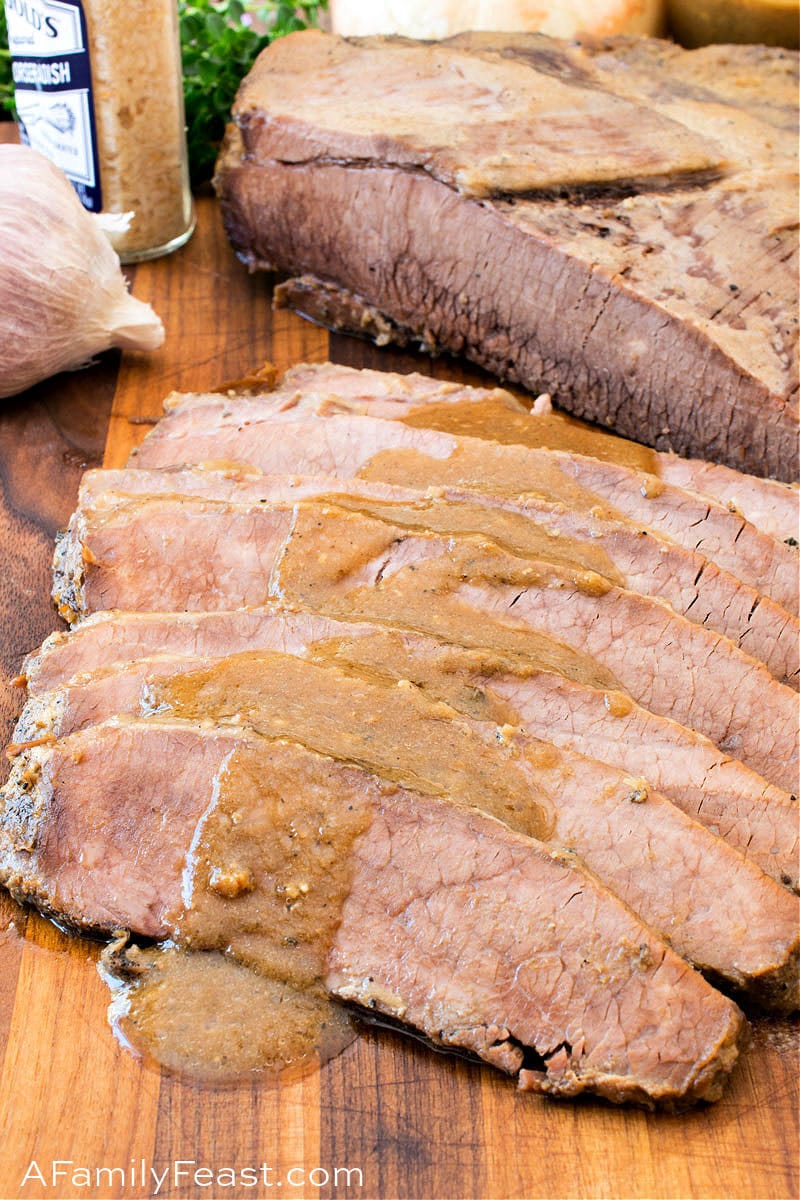
Say the word “brisket” and I’d be willing to bet that most of the time, you’re thinking of smoked or barbecued brisket. But – not everyone has the time, patience, or tools to make smoked brisket at home.
So instead, we set out to make an equally delicious, and very simple Oven-Roasted Horseradish Beef Brisket that anyone with an oven can make at home. You’ll serve your brisket with a fantastic horseradish-infused sauce made from the cooking liquids – and it’s absolutely delicious!
Like all brisket recipes, this one requires some time to prepare – but luckily, it’s easy and mostly ‘hands-off’ time.
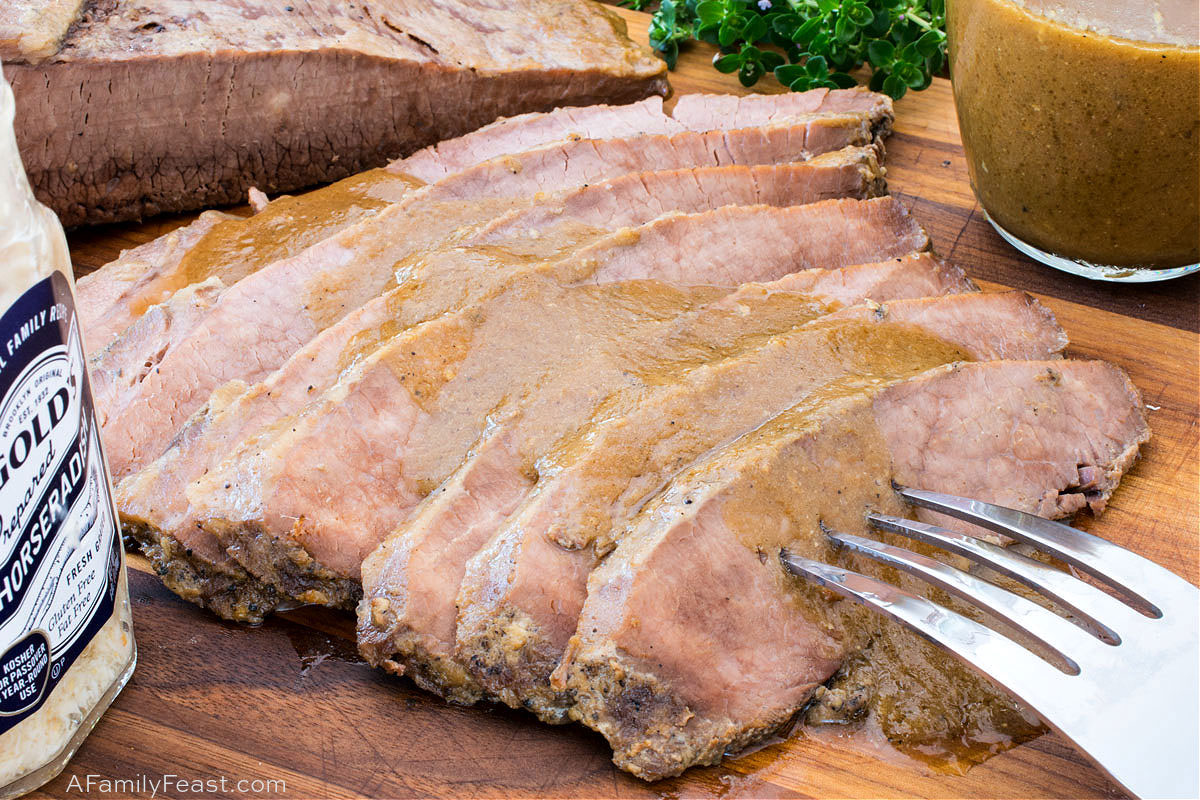
How do you make Oven-Roasted Horseradish Beef Brisket?
We selected a 6-pound beef brisket (*see our Notes below the recipe for buying tips). If your brisket has a lot of fat still attached, trim off any thick sections of fat, but leave some fat still attached. This will help keep the brisket moist and juicy as it roasts.
The day before you plan to eat, place the brisket on a flat rack placed over a baking sheet. Sprinkle salt and pepper on both sides of the beef, then refrigerate uncovered for at least 18 and ideally 24 hours.
This step is important: Over the next 24 hours the meat will first absorb, then release the salt and the pepper – seasoning the beef before you roast it in the oven. (If you don’t wait the full 18 to 24 hours, the meat will taste overly salty.)
Four hours or so before serving, brush off any excess salt from your brisket. Preheat your oven to 325 degrees F.
Pour beef broth into a baking pan large enough to accommodate your brisket lying flat. The rack is no longer needed.
Then, in a saucepan saute onions and garlic in butter, then add Worcestershire sauce, fresh thyme and bay leaves. Set aside. In a small bowl, mix together mayonnaise and horseradish. Slather the mayo-horseradish mixture over the fatty side of the brisket, then place the brisket in the roasting pan fat side up.
Pour the sauteed vegetables on top of the brisket, then cover the roasting pan with foil and place in the oven.
Roast for about 90 minutes, then – without opening the oven door – reduce the oven temperature to 250 degrees F. Roast your brisket for two more hours – then test for doneness, roasting longer if necessary.
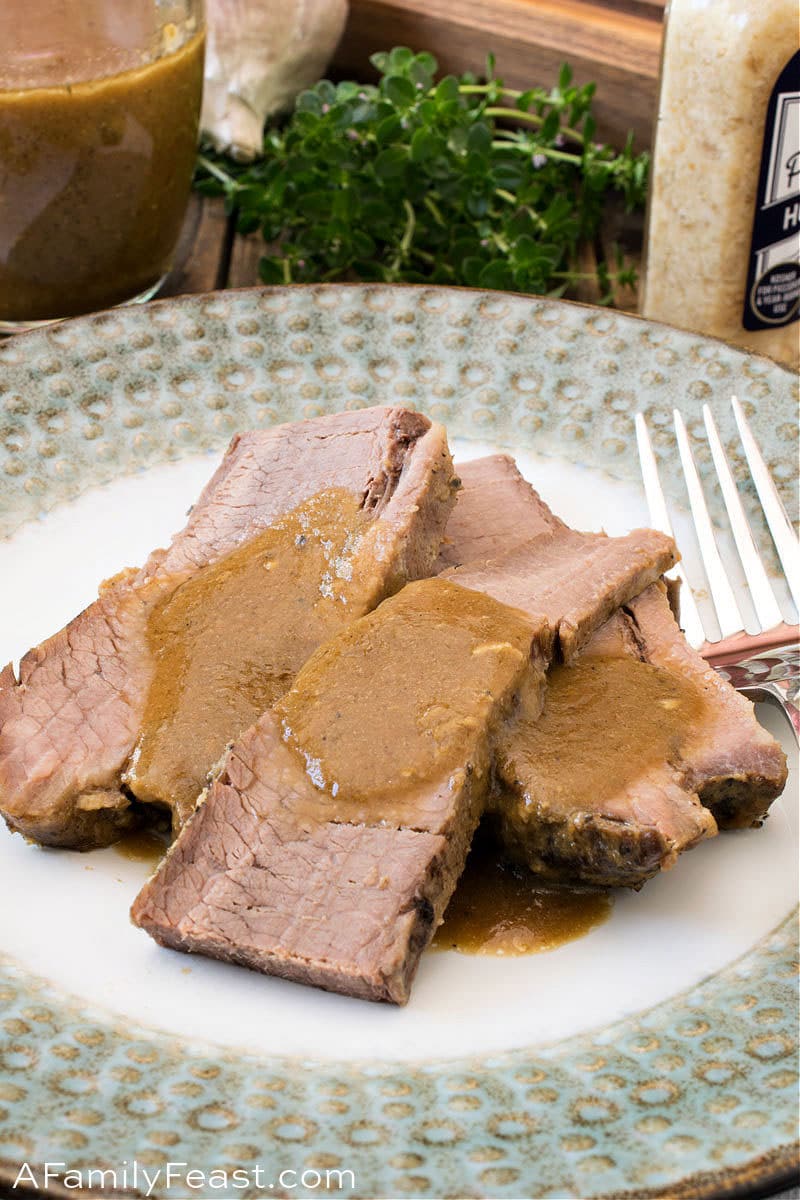
How can I tell when my brisket is done?
When the brisket is done, it should start to fall apart as you lift it from the rack. Slice off a little sliver of beef, cutting against the grain, and check for doneness. If it still seems a little tough and chewy, cover and roast longer.
How do I serve Oven-Roasted Horseradish Beef Brisket?
Once your brisket is done, carefully place the beef of a platter and allow it to rest.
Skim off as much fat as possible from the cooking liquid, and remove the bay leaves. Place the roasting pan over the burners on your the stove top (if your pan isn’t stove top safe, pour the liquid into a saucepan). Boil to reduce the liquid down to about two cups.
Once the liquid is reduced, pour into a blender (or use an immersion blender right in the pan) and puree. Strain the blended liquid – then spoon that over your brisket. Enjoy!
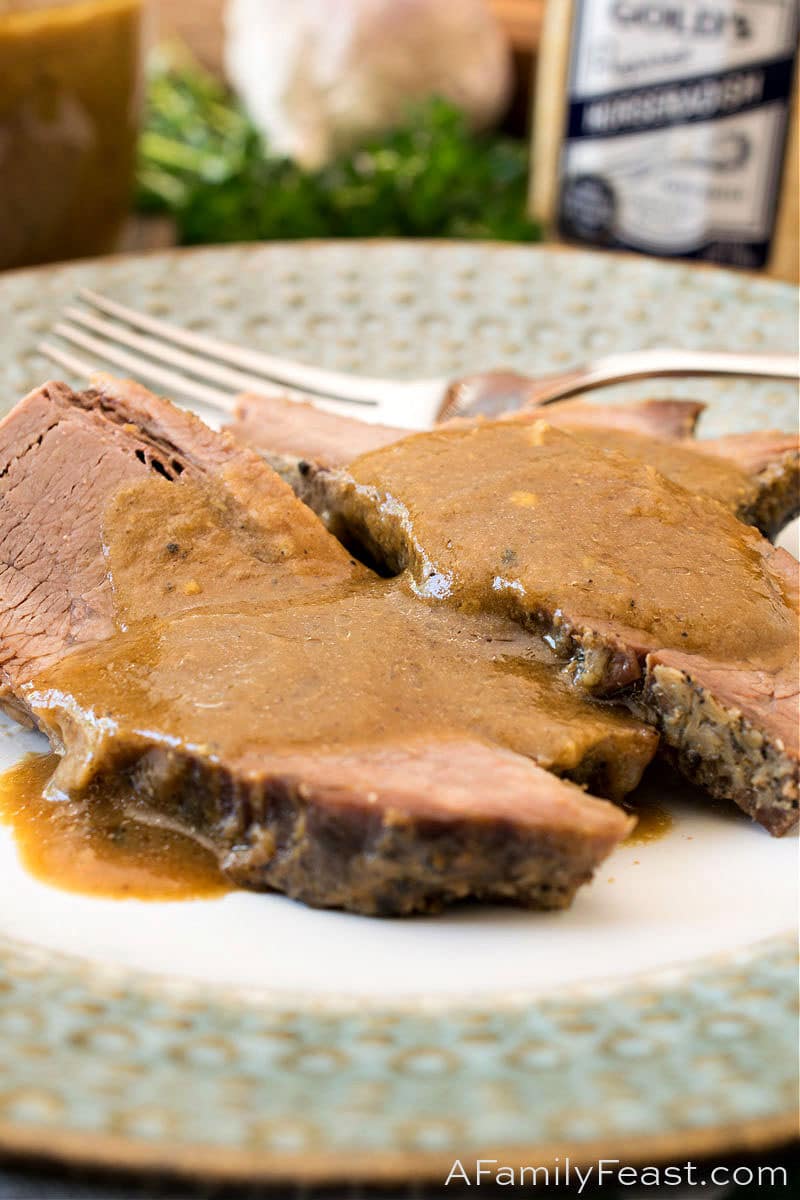
You may enjoy these other brisket recipes:
We love seeing what you made! Tag us on Instagram at @afamilyfeast or hashtag #afamilyfeast so we can see your creations!
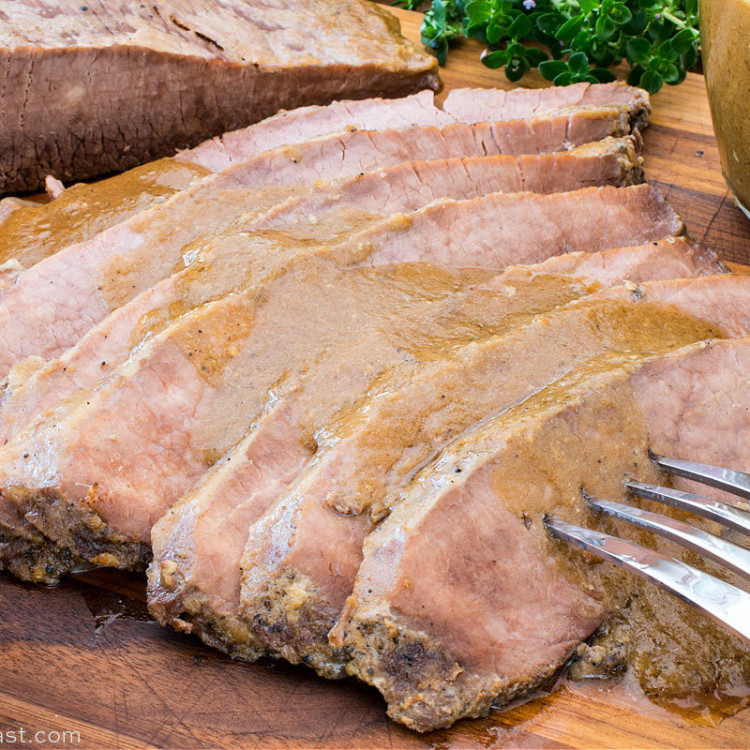
Oven-Roasted Horseradish Beef Brisket
Oven-Roasted Horseradish Beef Brisket is very easy to prepare – but it does take some ‘hands-off’ time. Super tender, super flavorful brisket is the reward for your patience!
Ingredients
6-pound brisket of beef (*See Note below about smaller roasts)
2 tablespoons kosher salt
2 tablespoons coarsely ground fresh black pepper
1 cup beef stock
4 tablespoons butter
1 large sweet onion, sliced thick
5 large garlic cloves, sliced
1 tablespoon Worcestershire sauce
4 sprigs fresh thyme
2 bay leaves
1 cup mayonnaise
1/4 cup drained horseradish
Instructions
- Cut off any large thick visible sections of fat but leave some still attached. Our roast was not that fatty so we did not remove any.
- Place a rack over a sheet tray lined with foil and lay the brisket over it and sprinkle both sides with the salt and pepper ending with the fat facing up.
- Refrigerate for 18-24 hours (24 hours is better) uncovered in the refrigerator.
- 4-5 hours before serving, preheat the oven to 325 degrees F.
- Brush off the surface salt and pepper. (It did its job by infusing salt and pepper into the meat. It’s fine to leave a little on the surface.)
- Pour the beef stock into the bottom of an appropriately sized roasting pan large enough to accommodate the roast lying flat.
- In a medium to large saute pan, melt the butter over medium heat and add the onions and cook for five minutes.
- Add the garlic and cook for one more minute.
- Add the Worcestershire sauce, fresh thyme sprigs and bay leaves and cook for one more minute then remove from heat and set aside.
- In a small bowl mix mayonnaise and horseradish.
- Remove the roast from the rack and smear the mayonnaise mixture all over the roast with most of it over the top fat side and lay the roast into the roasting pan over the beef stock.
- Pour the contents of the saute pan over the top of the beef and spread to the edges.
- Cover tightly with foil (always place shiny side of foil towards the food)** and place in the oven for 90 minutes.
- Without opening the oven door, lower temperature to 250 degrees F and continue to cook for two more hours (less if your roast is smaller).
- Pull off the foil and test for doneness. It should start to fall apart as you lift it. Slice off a little sliver against the grain and check for doneness. If more time is needed, seal back with foil and cook for up to 30 minutes longer.
- Lift the cooked roast and wipe the solids off the top and scrape back into the pan.
- Place the roast on a platter to rest and loosely cover with foil. We used two large spatulas to lift it out so it wouldn’t fall apart as we lifted.
- Ladle out as much of the fat that has floated to the top as possible and discard along with the bay leaves.
- Place the pan on the stove and boil down to about two cups.
- Pour the reduced liquid into a blender and puree or use an immersion blender.
- Pour this liquid into a sieve or strainer and use the back of a spoon to press it through the strainer. Discard the mash left in the strainer and use the liquid to serve with the beef. It should be slightly thick.
- Using a sharp long slicer knife, trim off any large pieces of fat then slice the brisket into thick slices against the grain and serve with the sauce.
Last Step! Please leave a review and rating letting us know how you liked this recipe! This helps our business thrive & continue providing free recipes.
Notes
*Brisket of beef typically comes as a full brisket which is usually about six pounds or in smaller three-pound pre-wrapped packages. If you are following this recipe with a smaller brisket, cut all other ingredients in half but follow the same method, reducing the oven time slightly to accommodate the smaller roast.
**Aluminum foil is manufactured with a shiny side and a dull side due to the manufacturing process. However in the kitchen, the shiny side reflects heat and the dull side absorbs heat. If you are covering a pan with food in it to bake, the shiny side should face the food and the dull side face up. If you are lining a pan with foil and plan on placing food on it to bake, the shiny side should face up, again to reflect heat up towards the food.
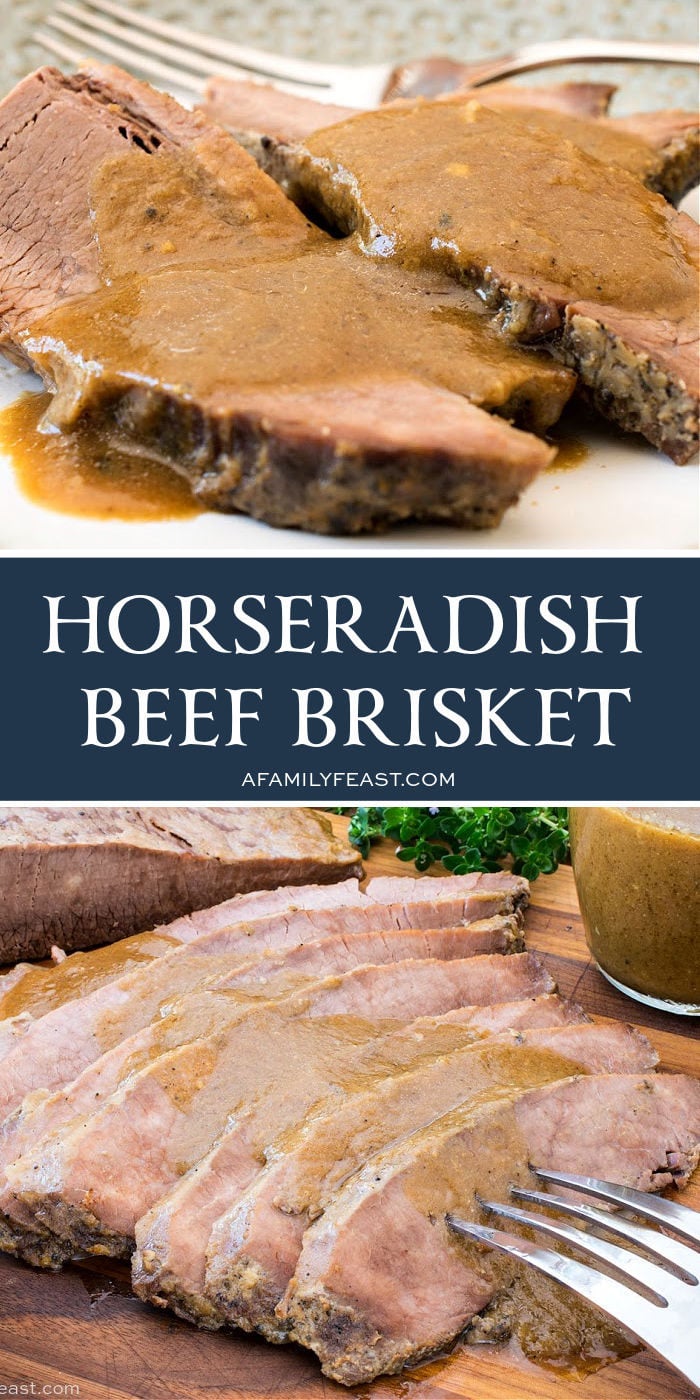
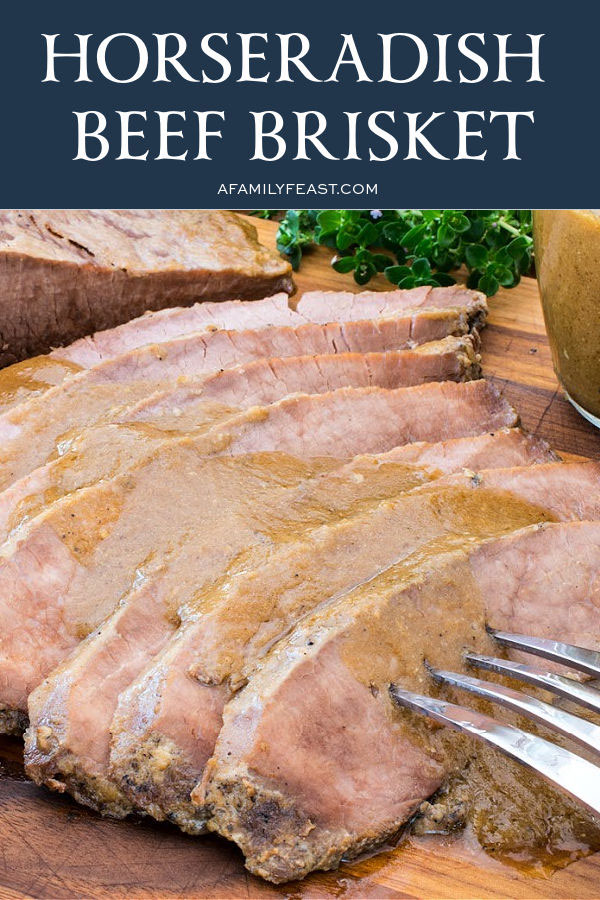
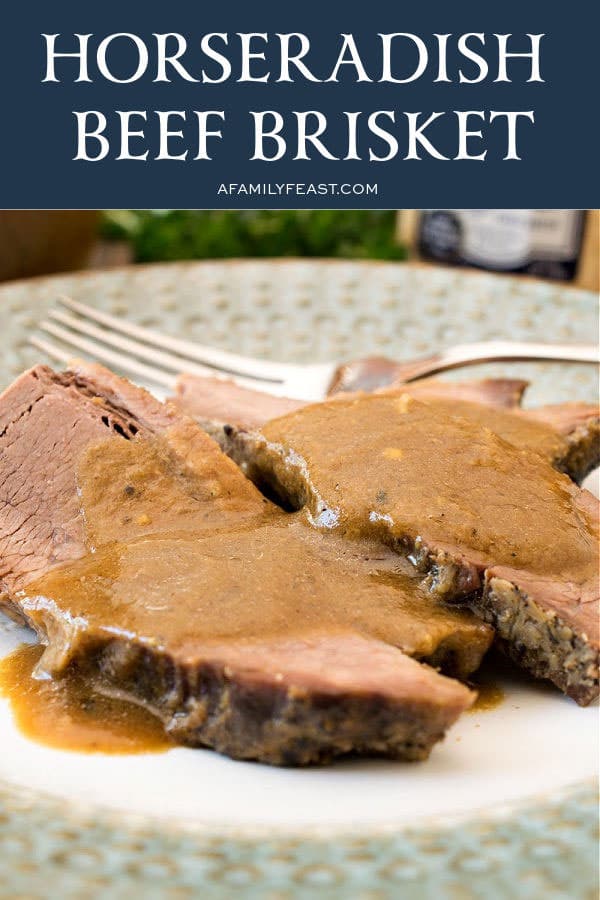
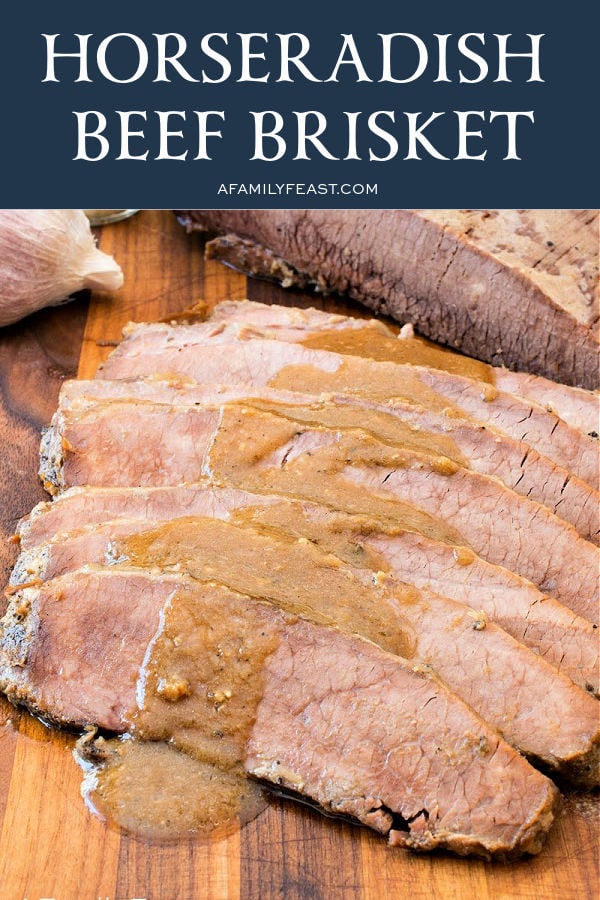
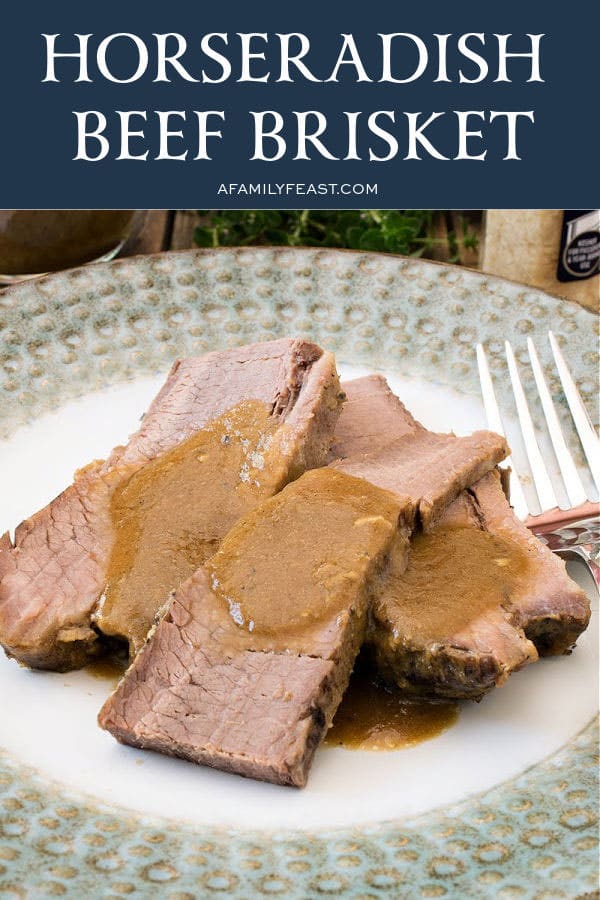

How can fresh horseradish be used? Or better to use jarred?
Hi Tamaryn
I grew fresh horseradish once (very invasive root by the way) and found it to be pretty intense compared to jarred. The only way I could calm it down was to peel and cook it first before using. Jarred “Prepared” horseradish is pickled in vinegar and much milder than fresh. Used in recipes, they sort of aren’t the same thing. Using fresh may be a bit harsh on the finished brisket.
Hope this helps,
Jack
I followed this recipe to the letter and we had it for dinner last night. I discovered the hard way that you can’t go by the temp with brisket. I cooked it for the recommended time, checked the temp, and it was 180, so I figured it was done. Unfortunately, I was wrong and the meat was very chewy and tough. I think it needed a LOT more time in the oven to break down the connective tissue. The sauce was delicious, but the meat was almost inedible.
Hi Jenna – Our recipe doesn’t state that the brisket would be done at 180…we specifically state that when the brisket is done, it should start to fall apart as you lift it from the rack. Slice off a little sliver of beef, cutting against the grain, and check for doneness. If it still seems a little tough and chewy, cover and roast longer.
Every brisket is different and different cuts may take longer – you can try to salvage your brisket by cooking it for longer, but again we’re not sure where in our recipe you got the impression that 180 degrees would be an indication that the brisket would be done.
Hi! Could you clarify a step for me, please? After removing from refrigerator overnight, is the meat placed back on the rack over the broth before placing in the oven?
Thanks for your time. My family and I enjoy your recipes!
Hi Pam – Yes – the meat is refrigerated flat on the rack, and then we placed the brisket (still on the rack) right in pan, over the broth, for baking. Hope that helps clarify!
Hi Martha,
This recipe looks amazing! I certainly will give it a try. What internal temperature do you recommend for doneness?
Great question Susan – 170 to 175 degrees internal temperature is a good target to start, but after testing for tenderness, feel free to roast for longer if necessary.